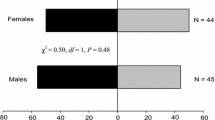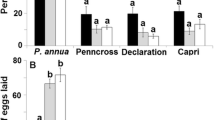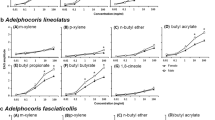Abstract
The antennae of Sitophilus granarius (L.) (Coleoptera: Curculionidae) adults detect a wide variety of compounds in the odor blend of various cereal grains (Germinara et al., Tec. Molit., 53:27–34, 2002). In the present study, we looked at the behavioral responses of the granary weevil to 20 of these individual volatiles (aliphatic alcohols, aldehydes, ketones, and aromatics) in a two-choice pitfall olfactometer, using the aggregation pheromone and propionic acid as the attractant and repellent controls, respectively. Five doses, ranging from 1 μg to 1 mg, of each compound were tested. At least one concentration of eight compounds attracted beetles but required doses 1,000- to 5,000-fold higher than the concentration of aggregation pheromone to elicit a response. Three compounds, while attractive at lower concentrations, acted as repellents at higher doses. Twelve compounds were repellent at concentrations similar to the quantity of propionic acid that significantly repelled beetles. The data show that granary weevil adults have the ability to respond behaviorally to a wide range of cereal volatiles and that responses may change as a function of concentration. The results suggest that host finding behavior of weevils will depend on the balance of positive and negative volatile stimuli from grain as the relative concentrations of volatiles may change during storage. An understanding of how the weevils respond to such changes could be useful for the development of effective integrated pest management strategies.

Similar content being viewed by others
References
Ansebo, L., Ignell, R., Löfqvist, J., and Hansson, B. 2005. Responses to sex pheromone and plant odours by olfactory receptor neurons housed in sensilla auricillica of the codling moth, Cydia pomonella (Lepidoptera: Tortricidae). J. Insect. Physiol. 51:1066–1074.
Chambers, J., Van Wyk, C. B., White, P. R., Gerrard, C. M., and Mori, K. 1996. Grain weevil, Sitophilus granarius (L.): antennal and behavioral responses to male-produced volatiles. J. Chem. Ecol. 22:1639–1654.
Collins, L. E., Wakefield, M. E., Chambers, J., and Cox, P. D. 2004. Progress towards a multi-species lure: comparison of behavioural bioassay methods for multi-species attractants against three pests of stored grain. J. Stored Prod. Res. 40:341–353.
Collins, L. E., Bryning, G. P., Wakefield, M. E., Chambers, J., and Cox, P. D. 2007. Progress towards a multi-species lure: identification of components of food volatiles as attractants for three storage beetles. J. Stored Prod. Res. 43:53–63.
Cox, P. D. 2004. Potential for using semiochemicals to protect stored products from insect infestation. J. Stored Prod. Res. 40:1–25.
De Cristofaro, A., Rotundo, G., and Germinara, G. S. 2000. Electrophysiological and olfactory responses of Ephestia kuehniella Zeller adults to cereals’ semiochemicals. IOBC-WPRS Bull. 23:189–194.
De Cristofaro, A., Ioriatti, C., Pasqualini, E., Anfora, G., Germinara, G. S., Villa, M., and Rotundo, G. 2004. Electrophysiological responses of codling moth, Cydia pomonella (L.) (Lepidoptera Tortricidae), to codlemone and pear ester ethyl (E,Z)-2,4-decadienoate: peripheral interactions in their perception. Bull. Insectol. 52:137–144.
Dickens, J. C. 1984. Olfaction in the boll weevil Anthonomus grandis Boh (Coleoptera: Curculionidae): electroantennogram studies. J. Chem. Ecol. 10:1759–1785.
El-Sayed, A. M. 2006. The Pherobase: Database of Insect Pheromones and Semiochemicals. <http://www.pherobase.com>.
Faustini, D. L., Giese, W. L., Phillips, J. K., and Burkholder, W. E. 1982. Aggregation pheromone of the male granary weevil, Sitophilus granarius (L.). J. Chem. Ecol. 8:679–687.
Germinara, G. S., Rotundo, G., De Cristofaro, A., and Giacometti, R. 2002. Risposte elettroantennografiche di Sitophilus granarius (L.) e S. zeamais Motschulsky a sostanze volatili dei cereali. Tec. Molit. 53:27–34.
Germinara, G. S., Rotundo, G., and De Cristofaro, A. 2007. Repellence and fumigant toxicity of propionic acid against adults of Sitophilus granarius (L.) and S. oryzae (L.). J. Stored Prod. Res. 43:229–233.
Grosh, W., and Schieberle, P. 1991. Bread, pp. 41–77, in E. Maarse (ed.). Volatile Compounds in Food and Beverages. Marcel Dekker, New York.
Heiniö, R.-L., Lehtinen, P., Oksman-Caldentey, K.-M., and Poutanen, K. 2002. Differences between sensory profiles and development of rancidity during long-term storage of native and processed oat. Cereal Chem. 79:367–375.
Kanaujia, K. R., and Levinson, H. Z. 1981. Phagostimulatory responses and oviposition behaviour of Sitophilus granarius L. to newly harvested and stored wheat grains. Z. Angew. Entomol. 91:417–424.
Kavitha, S., Shyamala, H., Muralikrishna, G., Varadaraj, M. C., and Rati Rao, E. 2005. Starch and cell wall degrading enzymes from fungal organisms grown on cereal and millet brans. Eur. Food Res. Technol. 220:560–564.
Landolt, P. J., and Phillips, T. W. 1997. Host plant influence on sex pheromone behavior of phytophagous insects. Annu. Rev. Entomol. 42:371–391.
Levinson, H. Z., and Kanaujia, K. R. 1981. Phagostimulatory responses of male and female Sitophilus granarius to newly harvested and stored wheat grains. Naturwissenschaften 68:44.
Levinson, H. Z., and Kanaujia, K. R. 1982. Feeding and oviposition behaviour of the granary weevil (Sitophilus granarius L.) induced by stored wheat, wheat extracts and dummies. Z. Angew. Entomol. 93:292–305.
Maga, J. A. 1978. Cereal volatiles: a review. J. Agric. Food Chem. 26:175–178.
Magan, N., and Evans, P. 2000. Volatiles as an indicator of fungal activity and differentiation between species, and the potential use of electronic nose technology for early detection of grain spoilage. J. Stored Prod. Res. 36:319–340.
Magan, N., Hope, R., Cairns, V., and Aldred, D. 2003. Post-harvest fungal ecology: impact of fungal growth and mycotoxin accumulation in stored grain. Eur. J. Plant Pathol. 109:723–730.
Molteberg, E. L., Magnus, E. M., Bjørge, J. M., and Nilsson, A. 1996. Sensory and chemical studies of lipid oxidation in raw and heat-treated oat flours. Cereal Chem. 73:579–587.
Morrison, W. R. 1987. Wheat lipid composition. Cereal Chem. 55:548–558.
Nawrot, J., Winiecki Z., Szafranek J., Malinski E., and Harmatha, J. 1995. Search for natural antifeedants and attractants for stored product pests, pp. 149–164, in Council of Europe (ed.). Proceedings of the International Forum on Stored Product Protection and Post-Harvest Treatment of Plant Products, Strasbourg, France.
Nielsen, G. S., Larsen, L. M., and Poll, L. 2004. Formation of volatile compounds in model experiments with crude leek (Allium ampelprasum var. Lancelot) enzyme extract and linoleic acid or linolenic acid. J. Agric. Food Chem. 52:2315–2321.
Olsson, P.-O. C., Anderbrant, O., Löfstedt, C., Borg-Karlson, A.-K., and Liblikas, I. 2005. Electrophysiological and behavioural responses to chocolate volatiles in both sexes of the pyralid moths, Ephestia cautella and Plodia interpunctella. J. Chem. Ecol. 31:2947–2961.
Olsson, P.-O. C., Anderbrant, O., and Löfstedt, C. 2006. Attraction and oviposition of Ephestia kuehniella induced by volatiles identified from chocolate products. Entomol. Exp. Appl. 119:137–144.
Pasanen, A.-L., Lappalainen, S., and Pasanen, P. 1996. Volatile organic metabolites associated with some toxic fungi and their mycotoxins. Analyst 121:1949–1953.
Phillips, T. W. 1997. Semiochemicals of stored-product insects: research and applications. J. Stored Prod. Res. 33:17–30.
Phillips, J. K., Chong, J. M., Andersen, J. F., and Burkholder, W. E. 1989. Determination of the enantiomeric composition of (R*,S*)-1-ethylpropyl 2-methyl-3-hydroxypentanoate, the male produced aggregation pheromone of Sitophilus granarius. Entomol. Exp. Appl. 51:149–153.
Phillips, T. W., Jiang, X.-L., Burkholder, W. E., Phillips, J. K., and Tran, H. Q. 1993. Behavioral responses to food volatiles by two species of stored-product Coleoptera, Sitophilus oryzae (Curculionidae) and Tribolium castaneum (Tenebrionidae). J. Chem. Ecol. 19:723–734.
Pierce, A. M., Pierce, H. D. Jr, Oehlschlager, A. C., and Borden, J. H. 1990. Attraction of Oryzaephilus surinamensis (L.) and Oryzaephilus mercator (Fauvel) (Coleoptera: Cucujidae) to some common volatiles of food. J. Chem. Ecol. 16:465–475.
Pierce, A. M., Pierce, H. D., Borden, J. H., and Oehlschlager, A. C. 1991. Fungal volatiles: semiochemicals for stored-product beetles (Coleoptera: Cucujidae). J. Chem. Ecol. 17:581–597.
Pike, V., Smith, J. L., White, R. D., and Hall, D. R. 1994. Studies on responses of stored-product pests, Prostephanus truncatus (Horn) and Sitophilus zeamais Motsch., to food volatiles, pp. 566–569, in E. Highley, E. J. Wright, H. J. Banks, and B. R. Champ (eds.). Proceedings of the Sixth International Working Conference on Stored Product Protection, Canberra, AustraliaCAB International, Wallingford, Oxon.
Piggot, J. R., Morrison, W. R., and Clyne, J. 1991. Changes in lipids and in sensory attributes on storage of rice milled to different degrees. Int. J. Food Sci. Technol. 26:615–628.
Rietdorf, K., and Steidle, J. L. M. 2002. Was Hopkins right? Influence of larval and early adult experience on the olfactory response in the granary weevil Sitophilus granarius (Coleoptera, Curculionidae). Physiol. Entomol. 27:223–227.
Sauer, D. B., Storey, C. L., and Walker, D. E. 1984. Fungal populations in US farming-stored grain and their relationship to moisture, storage time, regions and insect infestation. Phytopathology 74:1050–1053.
Sides, A., Robards, K., Helliwell, S., and An, M. 2001. Changes in the volatile profiles of oats induced by processing. J. Agric. Food Chem. 49:2125–2130.
Sinha, R. N. 1990. Role of odor volatiles in the stored grain ecosystem, pp. 3–13, in F. Fleurat Lessard, and P. Ducom (eds.). Proceedings of the Fifth International Working Conference on Stored Product Protection, Bordeaux, France. Imprimerie du Médoc, Bordeaux-Blanquefort, France.
Visser, J. H. 1986. Host odor perception in phytophagous insects. Annu. Rev. Entomol. 37:141–172.
Wakefield, M. E., Bryning, G. P., and Chambers, J. 2005. Progress towards a lure to attract three stored product weevils, Sitophilus zeamais Motschulsky, S. oryzae (L.) and S. granarius (L.) (Coleoptera: Curculionidae). J. Stored Prod. Res. 41:145–161.
Walgenbach, C. A., Burkholder, W. E., Curtis, M. J., and Khan, Z. A. 1987. Laboratory trapping studies with Sitophilus zeamais (Coleoptera: Curculionidae). J. Econ. Entomol. 80:763–767.
Zhou, M., Robards, K., Glennie-Holmes, M., and Helliwell, S. 1999. Analysis of volatiles compounds and their contribution to flavor in cereals. J. Agric. Food Chem. 47:3941–3953.
Acknowledgements
This study was supported by a grant from the Department of Animal, Plant and Environmental Sciences of the University of Molise, Campobasso, Italy.
Author information
Authors and Affiliations
Corresponding author
Rights and permissions
About this article
Cite this article
Germinara, G.S., De Cristofaro, A. & Rotundo, G. Behavioral Responses of Adult Sitophilus granarius to Individual Cereal Volatiles. J Chem Ecol 34, 523–529 (2008). https://doi.org/10.1007/s10886-008-9454-y
Received:
Revised:
Accepted:
Published:
Issue Date:
DOI: https://doi.org/10.1007/s10886-008-9454-y




